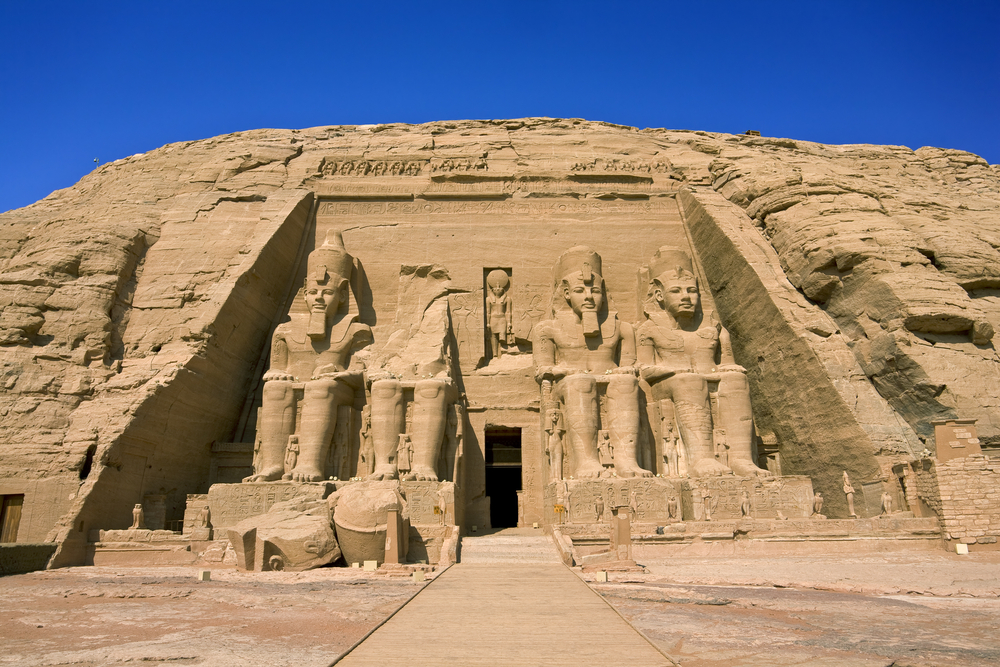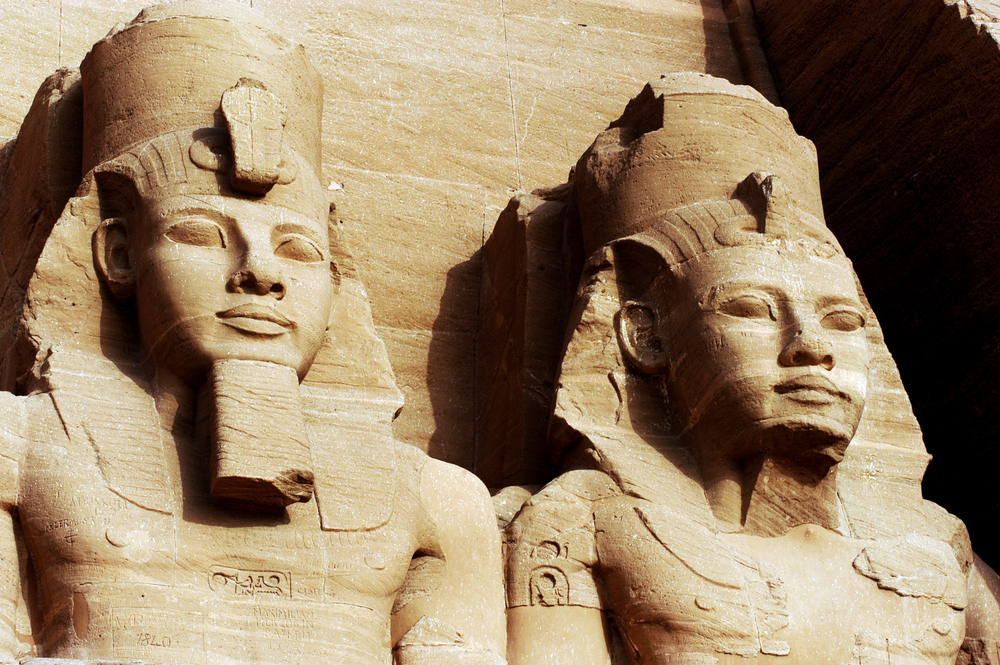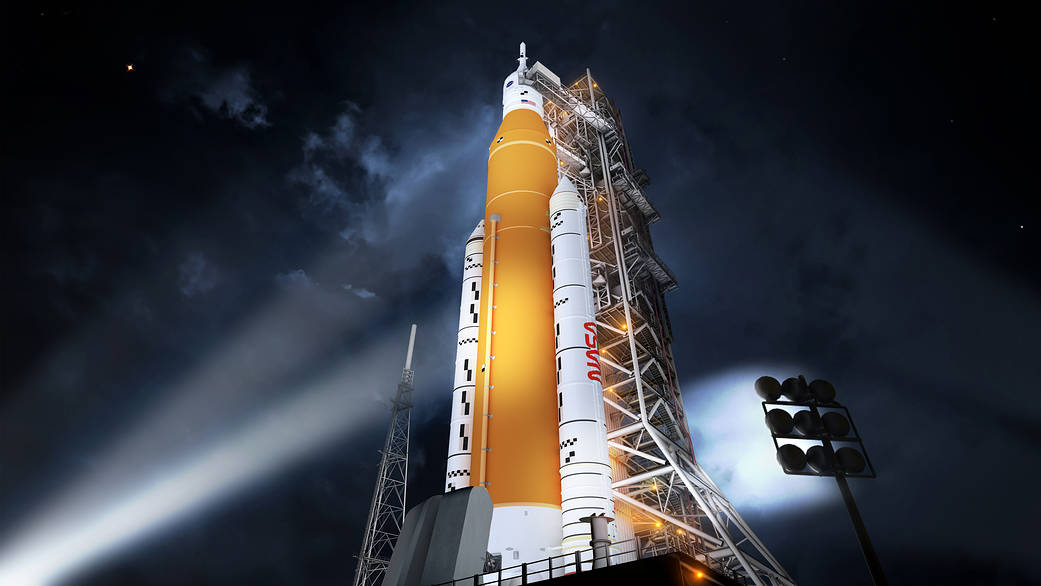Abu Simbel: The Temples That Moved
The site of Abu Simbel is one of the most recognizable ancient sites in Egypt. For 3,000 years, it sat on the west bank of the Nile River, between the first and second cataracts of the Nile. However, in a remarkable feat of engineering, the temple complex was dismantled and rebuilt on a higher hill to make way for the Aswan High Dam in the 1960s.
Built in 1244 B.C., Abu Simbel contains two temples, carved into a mountainside. The larger of the two temples contains four colossal statues of a seated pharaoh Ramesses II (1303-1213 B.C.) at its entrance, each about 69 feet (21 meters) tall. The entranceway to the temple was built in such a way that on two days of the year, October 22 and February 22, sunlight shines into the inner sanctuary and lights up three statues seated on a bench, including one of the pharaoh. Historians think these dates mark his coronation and birth. Thousands of tourists typically flock to the temples to watch the phenomenon and participate in the celebrations.
In addition, Abu Simbel has a second, smaller, temple that may have been built for queen Nefertari. Its front includes two statues of the queen and four of the pharaoh, each about 33 feet (10 meters) in height. Each is set between buttresses carved with hieroglyphs.
While the site was built by an Egyptian ruler, and is located within modern-day Egypt, in ancient times the place it was located in was considered part of Nubia, a territory that was at times independent of ancient Egypt.
“The waxing and waning of Egypt’s strength can be traced through its relations with Nubia. When strong kings ruled a united land, Egyptian influence extended into Nubia; when Egypt was weak, its southern border stopped at Aswan,” writes Egyptologist Zahi Hawass in his book "The Mysteries of Abu Simbel" (American University in Cairo Press, 2000).
Moving the temple
Abu Simbel survived through ancient times, only to be threatened by modern progress. Because the site would soon be flooded by the rising Nile, it was decided that the temples should be moved. “Following the decision to build a new High Dam at Aswan in the early 1960s, the temples were dismantled and relocated in 1968 on the desert plateau 64 meters (about 200 feet) above and 180 meters (600 feet) west of their original site,” writes Robert Morkot in an article in the "Oxford Encyclopedia of Ancient Egypt" (2001, Oxford University Press). The area where they were originally located is now flooded.
Hawass notes that moving the temples was a massive job, one that involved cutting it into pieces between 3 to 20 tons in weight and re-assembling them precisely as they were. It took almost five years, involved about 3,000 workers and cost (in the 1960s) about $42 million. He notes in his book that it was a great success, one reporter present at its completion wrote that “everything looks just as it did before; it is enough to make one doubt that the temples were moved at all.”
Get the world’s most fascinating discoveries delivered straight to your inbox.
Ramesses II
Ramesses II, sometimes called “the great,” was a warrior king who tried to expand Egypt’s territory far into the Levant. He battled another empire called the Hittites at the Battle of Qadesh (also spelled Kadesh) in Syria and also launched campaigns into Nubia.
He bragged about his accomplishments, embellishing Abu Simbel with scenes from the Battle of Qadesh. One image carved in the great temple at Abu Simbel shows the king firing arrows from his war chariot and supposedly winning the battle for the Egyptians. It was a blustery display for a battle that modern-day historians agree ended in a draw. Later, Ramesses II would make a peace treaty with the Hittites and cement it by marrying a Hittite princess, an event marked in a stela at Abu Simbel.
“Ramesses II is the most famous of the pharaohs, and there is no doubt that he intended this to be so,” writes University of Cambridge Egyptologist John Ray in a 2011 BBC article. “Ramesses II, or at least the version of him which he chose to feature in his inscriptions, is the hieroglyphic equivalent of hot air.”
But while Ramesses II may have been full of “hot air,” he did build some magnificent monuments, launching a major building program. “Ramesses II consolidated his godly state by building numerous temples in which he was worshipped in the image of the different gods,” writes Hawass in his book. And two of the finest temples he built were at Abu Simbel.
The Great Temple
Egyptologist Marco Zecchi writes in his book "Abu Simbel, Aswan and the Nubian Temples" (White Star Publishers, 2004) that the larger of the two Abu Simbel temples, the Great Temple, was known in ancient times as “the temple of Ramesses-Meryamun” which means “Ramesses, beloved by Amun” (Amun being an important deity in Ramesses II’s time).
Zecchi notes that the four seated statues of the pharaoh, at the entrance, show the ruler wearing a short kilt, nemes headdress, double crown with cobra and false beard. “Next to the legs of the four colossi are several smaller standing statues that represent the pharaoh’s relatives,” he writes, these include his wife Nefertari, the pharaoh’s mother Mut-Tuy, and his sons and daughters. Zecchi notes that at the top of the temple facade is “a row of 22 squatting baboon statues. The baboon’s cry was believed to welcome the rising sun.”
The interior of the temple stretches into the mountain for about 210 feet (64 meters). The first room is an atrium made up of eight pillars, four on each side, that Zecchi notes depicts Ramesses II in the guise of the god Osiris. The atrium area includes images and hieroglyphs describing Ramesses II’s supposed victory at the Battle of Qadesh. The atrium also has now empty storerooms on its sides.
Moving deeper into the temple there is a second atrium with four decorated pillars that Zecchi said shows the king “embracing various divinities as a sign of his spiritual union and predilection” and, at the very back, is a bench where a statue of Ramesses II is seated with three other gods, Ra-Harakhty, Amun and Ptah. Researchers have noted that on two days of the year (October 22 and February 22) all these statues, except for Ptah (who is associated with the underworld), are bathed in sunlight.
The Small Temple
As mentioned earlier, the smaller temple at Abu Simbel has, outside its entrance, four statues of pharaoh and two of his bride, Nefertari. Each statue is about 33 feet (10 meters) tall, a buttress in between each of them. Zecchi notes that the facade also contains smaller statues of the children, “oddly the statues of the princesses are taller than those of the princes,” a sign, perhaps, that this temple pays tribute to Nefertari and the women of Ramesses II’s household.
The interior of the temple is simpler than that of the great temple. It contains six pillars that show depictions of the goddess Hathor. Zecchi notes that on the “back wall of the room” are reliefs showing “Nefertari in the act of being crowned by the goddesses Hathor and Isis,” the queen wearing a head covering that shows “the solar disc with feathers between cow horns” the same head covering the goddesses are wearing.
Rediscovery
At some point the temples were abandoned and, in the period afterwards, were covered with sand, the great colossi gradually disappearing into the desert. Hawass notes that Johann Ludwig Burckhardt noted the existence of the site in 1813. Then, in 1817, a circus strongman named Giovanni Belzoni uncovered the buried entrance to the great temple.
This entrance, which was precisely aligned with the sun so as to light up three of the statues within for two days of the year, now saw light once again.
Additional resources

Owen Jarus is a regular contributor to Live Science who writes about archaeology and humans' past. He has also written for The Independent (UK), The Canadian Press (CP) and The Associated Press (AP), among others. Owen has a bachelor of arts degree from the University of Toronto and a journalism degree from Ryerson University.
 Live Science Plus
Live Science Plus







